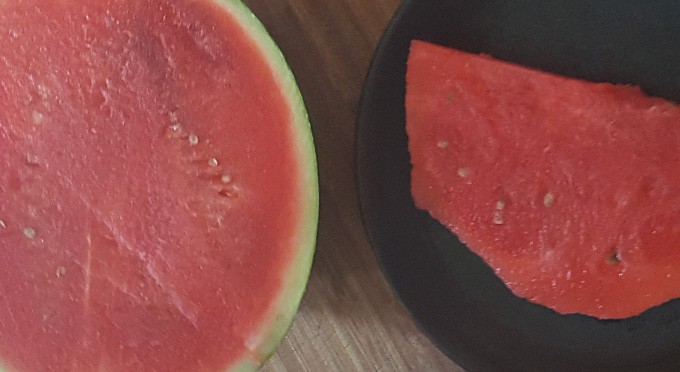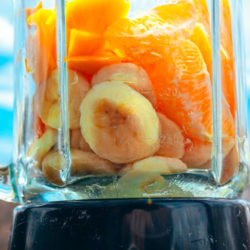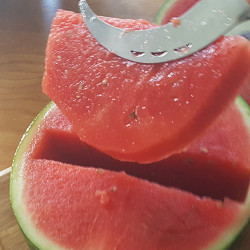 When thinking about watermelon, most of us visualize a large, round fruit that’s bright green on the outside, and dark red on the inside. Cut it open, and you’ll reveal the vibrantly colored flesh with seeds speckled throughout. If you were to talk about the specific look of these seeds, you would probably picture and describe them as black. This classic vision of an iconic, summertime fruit is based on a traditional look, and memories of watermelons from the past, but if you actually cut one open today, you would see very few of those larger and more solid, black seeds that you’re used to. Instead, you’ll be met with white versions that are far less substantial in comparison.
When thinking about watermelon, most of us visualize a large, round fruit that’s bright green on the outside, and dark red on the inside. Cut it open, and you’ll reveal the vibrantly colored flesh with seeds speckled throughout. If you were to talk about the specific look of these seeds, you would probably picture and describe them as black. This classic vision of an iconic, summertime fruit is based on a traditional look, and memories of watermelons from the past, but if you actually cut one open today, you would see very few of those larger and more solid, black seeds that you’re used to. Instead, you’ll be met with white versions that are far less substantial in comparison.
Black Vs. White
More than a mere change of appearance, the two types of seeds found in watermelons are very different, but the difference is caused by one simple factor; maturity. Basically speaking, black seeds are mature seeds, and white ones are not. If you bury one of each in the ground, only the dark and fertile seed would result in a new plant growing. The white ones, in any quantity, would not. Although this may seem like a minor variance, this one factor leads to a number of pretty significant differences.
Black Seeds
When compared to their pale counterparts, these seeds will be much bigger in size. They will be thicker in girth, and the shell will be hard with dark black coloration. You can eat this type of seed, but most people spit them out while enjoying the fresh fruit. If you did bite down on one, it would be hard and crunchy between your teeth. You’ll find this type of seed in a smaller percentage of melons found in grocery stores due to current consumer trends, but they will always be considered “regular” when referring to natural and normal watermelon seeds.
White Seeds
These lightly colored seeds are often almost translucent in color, but they are generally referred to as white. Due to convenience and other factors, many watermelon varieties are altered to encourage infertile seeds, and discourage any seeds from reaching full maturity. You’ll always find a few of these immature seeds in any watermelon, but newer “seedless” varieties attempt to eliminate black seeds altogether. The small and soft white seeds are easily consumed without a thought because there is little taste or crunch, if any, when you encounter one. Although some people claim that the fruit tastes different in melons with white seeds, farmers and other experts seem to agree that breeding to reduce seed maturity does not actually change the taste.
How Many Are There?
Sometimes it seems like there are too many, and that may be a big reason why so many people like the white ones, but on average, every watermelon has about the same number of seeds. Give or take. The numbers show that the average watermelon grown in the United States has about 250 to 750 seeds, and there are usually about 5 percent that are still immature come harvest time. Every one will begin life immature and white, but depending on variety of fruit, many will grow, harden, and change color with time.
What Makes Them White?
If allowed to grow naturally, most seeds inside a watermelon will reach full maturity, and for American varieties, this means a large, black appearance. Because most people seem to prefer melons without obstacles, farmers are mostly growing fruit that is full of immature white seeds that are more readily edible, and they use a chemical reaction to make it happen.
Colchicine is a chemical derived from the crocus plant, and it was originally developed as a treatment for gout in ancient Egypt. In more recent times, it has been used by scientists to impact certain aspects of chromosome development in plants. When watermelon plants are treated with this chemical, the flowers will end up developing two sets of chromosomes instead of one. When these treated flowers are pollinated, they create triploid cells that are capable of developing into fruit, but not capable of producing genetically viable seeds. For this reason, they will be unable to be fertilized, so they will never mature, or develop the hard black seed coat.
Hard White Seeds?
The underdeveloped and immature seeds that most people refer to as white here in the United States should not be confused with the mature, white seeds that can be found in specific varieties grown in China and parts of the Middle East. Watermelon is a versatile fruit with a wide range of varieties and combinations grown worldwide, so you can find ones with rind, seed, and flesh colors that you would consider weird, but the red and black interior Americans are used to is nothing more than an aesthetic choice of farmers that became a household standard. If you’re slicing into a melon on the other side of the planet, the answer might be slightly different, but around here the question usually comes up when someone notices the immature white seeds in comparison to the shiny black ones, or when conversing about so-called seedless versions of the fruit.
The Benefits
Although most people justy spit them out, black watermelon seeds actually have impressive nutritional value, and they are widely consumed as a snack food, all around the world. Usually roasted and salted like sunflower seeds, they are high in protein and other vital nutrients. Instead of cooking them, you can also sprout them to eat them raw, or use as an ingredient in a range of recipes. Despite the fact that most people typically dispose of them, when you eliminate black seeds, you also forfeit a potential food source and a tasty treat.
White seeds, in comparison, offer the ultimate in convenience and safety. You won’t be able to use them outside of the melon, and they won’t offer any additional nutritional value, but they do make it less annoying for many people to eat watermelon. Kids and adults can easily consume these baby-size seeds along with the flesh, and there’s no worry about choking, digestion, or plants growing in your stomach(this one’s not actually possible). With no anxiety or burden caused by the need to spit seeds to the side, many people find it easier to enjoy this delicious fruit.





 Ordering Info
Ordering Info Customer Service
Customer Service Follow Us
Follow Us Search For Stuff
Search For Stuff Find Us
Find Us Call Us
Call Us Pay Us
Pay Us

Black seeds are original mostly fertile white small seeds is the side effect of Monsanto …bananas,grapes,zucchini use to have seeds …not anymore so you can’t use them if any and have to keep buying….and don’t spray dandelions on your lawn ,don’t beg the leafs build a compost box.